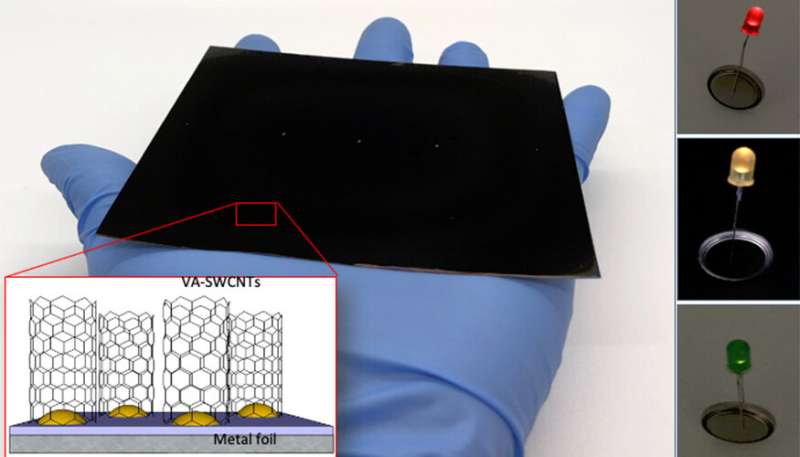Photograph and schematic representation (inset) of a scaled-up sample of vertically-aligned single-walled carbon nanotubes (VA-SWCNTs) grown on Inconel metal foil. Side pictures show half-cells based on VA-SWCNT anodes illuminating red, yellow and green LEDs. Credit: Lawrence Livermore National Laboratory
Lawrence Livermore National Laboratory (LLNL) scientists have created vertically aligned single-walled carbon nanotubes on metal foils that could be a boon for energy storage and the electronics industry.
Vertically aligned carbon nanotubes (VACNTs) have exceptional mechanical, electrical and transport properties in addition to an aligned architecture, which is key for applications such as membrane separation, thermal management, fiber spinning, electronic interconnects and energy storage.
To date, widespread integration of VACNTs into next-generation technologies is thwarted by a lack of compatible, economic, mass-production capabilities. High-quality VACNTs are typically made on substrates such as silicon (Si) or quartz wafers that are rigid, expensive and electrically insulating.
After exploring metal foil options in scientific literature, the LLNL team turned to Inconel metal substrates allowing them to integrate VACNTs into flexible devices, eliminate a transfer step from Si to other substrates and minimize electrical or thermal transport resistances at the interface between CNTs and the substrate, which is critical for electronic and energy storage applications. Inconel is a family of nickel-chromium-based superalloys that are oxidation-corrosion-resistant materials well-suited for service in extreme environments subjected to pressure and heat.
"Transitioning growth of high-quality CNTs from traditional Si substrates to metal foils opens the door to more economical, large-scale, semicontinuous and roll-to-roll manufacturing of multifunctional CNT composites, nanoporous membranes and electrochemical devices," said LLNL scientist Francesco Fornasiero, co-author of a paper appearing in the journal ACS Applied Materials & Interfaces.
Synthesis of high-quality single-walled CNTs (SWCNTs) on metal foils would be especially valuable for energy-storage devices, such as lithium-ion batteries (LIBs). While graphitic materials are common LIB anodes, their capacity falls short of rapidly evolving energy-storage needs.
"The high surface area and exceptional electronic conductivity of CNTs make them prime candidates for high-capacity, high-rate electrochemical applications," said LLNL scientist Kathleen Moyer-Vanderburgh, lead author of the paper. "In particular, VA-SWCNTs grown on metal foils could provide a binder-free platform with strong adhesion between the SWCNT and current collector, enhanced conductivity and aligned channels for rapid Li-ion diffusion."
The LLNL team grew forests of vertically aligned SWCNT on Inconel metal for use as a LIB anode. Team members found nearly invariant structural properties of the CNT forests over a wide range of synthesis conditions and for multiple metal substrates. Fabricated VA-SWCNT LIB anode displayed stable cycling for hundreds of cycles and large capacity even at high cycling rates.
"Our results suggest that these SWCNTs on Inconel metal are promising materials for high-performance electrochemical devices," said LLNL scientist Jianchao Ye.
More information: Kathleen Moyer-Vanderburgh et al, Growth and Performance of High-Quality SWCNT Forests on Inconel Foils as Lithium-Ion Battery Anodes, ACS Applied Materials & Interfaces (2022). DOI: 10.1021/acsami.2c18396
Journal information: ACS Applied Materials and Interfaces
Provided by Lawrence Livermore National Laboratory
























